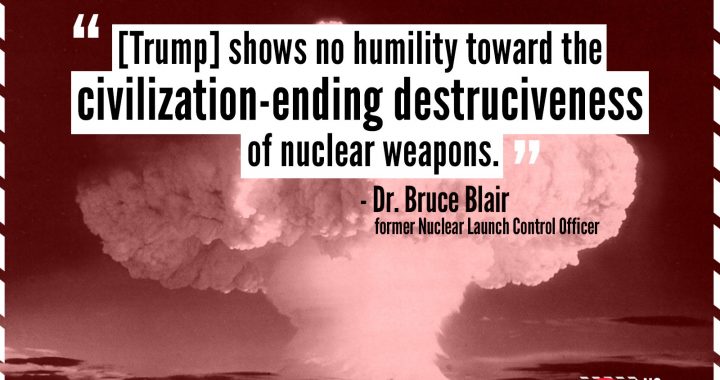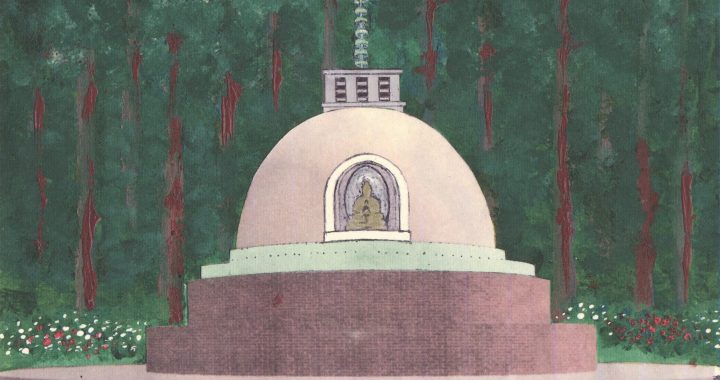Editor’s Note: The community of people working to abolish nuclear weapons and the associated risk of nuclear annihilation is relatively small, and each person brings a unique experience and important perspective. All are important when considering the magnitude of the task, and what is at stake. Our colleague, Dr. Bruce G. Blair, a former minuteman ICBM launch control officer and nuclear security expert, died yesterday, Sunday, July 19th. He brought much to the movement!
We share the following article that Dr. Blair wrote in 2003. At a time when the US is ramping up nuclear weapons production and increasing the role of nuclear weapons in US foreign policy, this article is as pertinent now as it was then. As he says in this article, “Designing bunker busters and mini-nukes or any other new nuclear weapon is yesterday’s agenda. The old nuclear game is ending.” We are grateful for Dr. Blair’s life and legacy, and can best honor it by continuing to resist and work to abolish these horrendous weapons of mass extinction.
**********
Opinion: We Keep Building Nukes For All the Wrong Reasons
The source of this article is: The Washington Post Sunday May 25th, 2003
By Bruce G. Blair
You would think the United States would be getting out of the business of pursuing new nuclear weapons. After all, the Cold War is over, President Bush warns of the danger of weapons of mass destruction and the administration has cast doubt on the role of deterrence in stopping the greatest threats of the 21st century — “rogue states” and terrorists.
Yet last week Congress approved further research on nuclear bunker busters, weapons that can penetrate deeply into the ground before exploding, and “mini- nukes,” weapons with explosive yields below five kilotons. Although spending on these programs will remain minuscule by Pentagon standards, the stakes are higher than the dollars suggest. America’s nuclear future hangs in the balance. The underlying question: If the United States wants to reduce nuclear tensions and arsenals, why is anyone at the Pentagon even thinking about building new nuclear weapons?
In the public debate over bunker busters and mini-nukes, it is commonly assumed that the weapons’ primary targets are the states still turning on the “axis of evil” — Iran and North Korea — as well as the other leading candidates for that dubious distinction: Syria, Sudan, Libya and Algeria. All have aspired at one time or another to acquire chemical and biological, if not nuclear, weapons. These countries indeed have come into the nuclear cross hairs of the U.S. Strategic Command (SAC) in Omaha, Neb. Nuclear targeting of a dozen or so countries is a cottage industry now that President Bush has blessed the notion that U.S. nuclear weapons can, and should, be adapted for use against a growing list of enemy weapons in a widening array of circumstances. That notion was floated by Bush’s 2001 Nuclear Posture Review, and codified in presidential nuclear guidance issued in 2002.
The military utility of new U.S. nukes, however, would be limited, while the risk to local civilians and friendly soldiers would be high. A nuclear bunker buster powerful enough to destroy a deeply buried target would not penetrate the Earth far enough to avoid venting deadly radioactive material into the atmosphere. The practical maximum depth for earth-penetrating warheads currently may not exceed 50 feet or so; at that depth, the warhead yield could not exceed a small fraction of one kiloton without spewing fallout. If strength of the warhead were that small, it might not destroy a hardened subterranean target. So the choice is between an ineffective weapon or one that could kill many thousands of local inhabitants and friendly soldiers.
No U.S. regional commander would approve nuclear strikes of questionable military impact that would also contaminate a battlefield, especially given the variety of non-nuclear options at his disposal, from precision-guided conventional weapons to assaults by Special Forces. Even against the most subterranean of adversaries — North Korea, with its innumerable caves and mazes — nuclear strikes and the contamination left behind would merely complicate and delay a conventional victory that even South Korea alone could win within 10 to 30 days.
Die-hard nuclear war planners actually have their eyes on targets in Russia and China, including missile silos and leadership bunkers. For these planners, the Cold War never ended. Their top two candidates in Russia are located inside the Yamantau and Kosvinsky mountains in the central and southern Urals. Both were huge construction projects begun in the late 1970s, when U.S. nuclear firepower took special aim at the Communist Party’s leadership complex. Fearing a decapitating strike, the Soviets sent tens of thousands of workers to these remote sites, where U.S. spy satellites spotted them still toiling away in the late 1990s. Yamantau is expected to be operating soon.
According to diagrams and notes given to me in the late 1990s by SAC senior officers, the Yamantau command center is inside a rock quartz mountain, about 3,000 feet straight down from the summit. It is a wartime relocation facility for the top Russian political leadership. It is more a shelter than a command post, because the facility’s communications links are relatively fragile. As it turned out, the quartz interferes with radio signals broadcast from inside the mountain. Therefore the main communications links are either cable or radio transmitters that broadcast from outside the center. These are vulnerable to nuclear weapons from the existing U.S. arsenal and would be even more vulnerable to new bunker busters.
Kosvinsky is regarded by U.S. targeteers as the crown jewel of the Russian wartime nuclear command system, because it can communicate through the granite mountain to far-flung Russian strategic forces using very-low-frequency (VLF) radio signals that can burn through a nuclear war environment. The facility is the critical link to Russia’s “dead hand” communications network, designed to ensure semi-automatic retaliation to a decapitating strike.
This doomsday apparatus, which became operational in 1984 during the height of the Reagan-era nuclear tensions, is an amazing feat of creative engineering. It features hard radio nodes near Moscow that can use remote control to launch communications rockets, which in turn can launch virtually the entire Russian missile force without human intervention. But the Moscow-area radio nodes have grown vulnerable over the past 20 years. Kosvinsky restores Russia’s confidence in its ability to carry out a retaliatory strike.
Kosvinsky came on line recently, which could be one explanation for U.S. interest in a new nuclear bunker buster. If there’s a new item on the target list, U.S. strategy requires a weapon to destroy it. Even with a “robust nuclear earth penetrator,” as the bunker buster is called, destroying Kosvinsky is not an easy assignment; the command center is protected by roughly 1,000 feet of granite. More importantly, why would we want to if Russia is no longer the enemy?
While logical in the alternate universe of Cold War-era nuclear war planning, building a new weapon to threaten these mountain redoubts would not increase our security. President Bush’s nuclear guidance doubtless instructs the Pentagon to plan the destruction of Yamantau and Kosvinsky, along with 2,000 other targets in Russia and hundreds more in China. But such targeting requires very high-yield weapons, typically 10 to 100 times more destructive than the bombs dropped on Japan in 1945. We are talking about a doomsday plan in which Yamantau and Kosvinsky are struck as part of an all-out nuclear exchange that would kill hundreds of millions of people. Apart from the horror of such destruction, now that Russia is no longer the “evil empire,” such a war seems more and more far-fetched.
So what is the real driving force behind the administration’s chase for bunker busters and mini-nukes? It is the U.S. nuclear security establishment’s desire to preserve — indefinitely — a nuclear weapon design capability at the national laboratories, particularly Los Alamos and Lawrence Livermore. The labs fear that atrophying intellectual capital in this arena would leave the United States crippled if it ever wished to re-start a nuclear design effort in a national emergency. They are therefore trying hard to portray new nuclear weapons as essential to national security.
This argument is self-serving for the national laboratories. Officials there recognize that their mission is shrinking. Where nuclear weapons once offered unique military solutions, precision conventional weapons now can do the job. As long as two decades ago, a SAC study found that most of the Soviet “soft” targets, such as electricity generating plants located east of the Ural Mountains, could be destroyed by cruise missiles armed with conventional warheads. SAC actually proposed replacing nuclear weapons with such warheads in the U.S. strategic war plan. But both Strategic Command and the nuclear laboratories are peddling the case for bunker busters and mini-nukes because of their own stakes in new nuclear weapons.
At another level, however, this is not only a story of bureaucratic self-interest. The nation faces a profound choice. The United States can continue basic nuclear weapons research. However, it should forgo designing, building, testing and fielding new weapons. This would enable the nation to maintain and nurture its storehouse of intellectual capital, while adequately supporting critical missions such as nuclear bomb disposal and safeguards. And it would still promote nonproliferation and arms control.
Designing bunker busters and mini-nukes or any other new nuclear weapon is yesterday’s agenda. The old nuclear game is ending. The new missions that will make Americans secure and attract new recruits to the nuclear enterprise almost certainly will revolve around the challenge of preventing nuclear terrorism.
Bruce Blair, a former Minuteman launch officer, was most recently President (and co-founder) of the Board of Directors of Global Zero. Click here to learn more about Dr. Blair.
The original article, “We Keep Building Nukes for All the Wrong Reasons,” originally published in The Washington Post, May 25, 2003, is archived at Global Zero: https://www.globalzero.org/wp-content/uploads/2019/03/BB_We-Keep-Building-Nukes-for-All-the-Wrong-Reasons_05.25.2003.pdf




